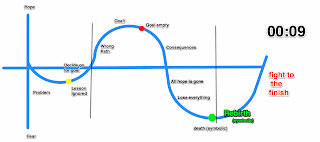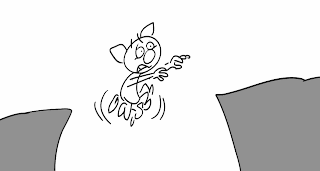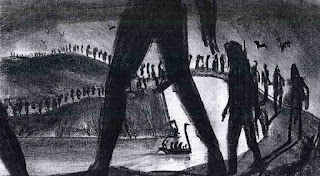It's still winter but in Southern California, where I am right now, the weather feels like spring is here. So it's time to continue to our next step...
Here's the overview of where our character has gone swinging between hope and fear over time. And we've been in the roller coaster seat right along with them. This is the very big picture with the smaller bumps smoothed out. Along the way there's been lots of smaller glimpses of hope and reasons for fear. We'll explore those after we finish the big picture.
Many of these items may "sound" familiar. And they should, it's all of the items that I've learned from the plot point theories that have helped me understand the writing process. Only now, for the first time, I can "see" how they all fit together to guide me. In the next graph, you can see where the act breaks fall, indicated by vertical lines.
Being able to see it has also allowed new insights to emerge that couldn't be "seen" before. In fact, as I did this graph this morning, I noticed something new. I wanted to visually point out where the turning point are where hope turns to fear, or vice versa, and I realized they reminded me of a stop light.
First, we have the warning of the lesson. It's a yellow light. What does it mean when you see a yellow light?
POP MINI QUIZ:
What does it mean when you see a yellow light?
a. Stop
b. Slow down
c. Speed up
d. Turn around
e. All of the above
The answer from the drivers manual is, of course, (b) slow down. But what do drivers do when they see a yellow light? They speed up to make it through the light. Isn't that like ignoring the lesson. The psychology behind this structure is amazing.
When the character thinks they've achieved their goal, they have to stop. They reach the red light. It's in the silence that they realize their goal was empty and they face the consequences.
Then they symbolically die. Doesn't it seem like red lights last forever? Maybe red lights were invented to give us moments to look at our lives. Think about it next time your'e waiting for a red light.
Our next step in the big picture of mapping our story structure is for death to somehow be turned around. After all, our character is not really dead, only symbolically. I, being visually oriented, would add in the imaginary too. Film is a visual medium. Even novels are describing the world visually. The character has died symbolically and imaginarily. We need to show it to the audience so they can feel it. I covered this in my first book,
Directing the Story.
So what turns the situation around for the character? Is there anything in our story to give us a clue? We're weaving a story together here and the item, I'm thinking about, has already returned once. It's the lesson. The lesson returned around the red light showing the consequences of ignoring the lesson. Now, the character has grown from painful experience and is now ready to hear the lesson. They have realized their way of doing things has not worked. It's been a painful death of the old ways. The lesson returns. It has traveled the path of the lights, from yellow to red to green. Easy way to remember it just like a real stop light- yellow, red, green.
Now they learn the lesson and they are reborn. What does this mean? In the great cycle of birth and death comes rebirth. Spring is here.
The rebirth is a change in perspective like seeing something you couldn't see before. That's exactly why the character ignored the lesson. They couldn't see it or weren't ready to hear it. We're talking about a paradigm shift. It reminds me of a story...
There was once a bunch of ants walking along on a giant flat field gathering food. Over time the food seemed to be diminishing. But they keep walking ahead. One day the food was all gone. At that point a butterfly arrived. They asked the butterfly if had seen any food. He told them that he had been watching them and was puzzled why they keep walking around the Mobieus strip they were on. He saw that they had looped around eating the food until there was none left. Told them this and explained that a Mobieus strip is a loop of paper with a single twist in it that makes the paper have only one side. What did the ants do? Well, they thought the butterfly was absolutely crazy. He wasn't making any sense. So they ate him.
What's the point of this story? Well, the ants could only see things from their perspective. Their "reality" was the images they saw and the symbols they used to represent their experience. They only knew they were walking on a flat surface. The butterfly's experience of "reality" was different because he could fly around in multiple dimensions. He had a different paradigm.
There's one more point to this story. This one is about the real. The ants ate the butterfly. Did they eat him because he was food or because he was blowing their minds? People don't like to have their worlds shattered. Thats what happens when a paradigm shifts. Trees that don't bend in the wind break.
Two blog posts back, I presented a quiz. If the character's life unravels, what does that do to the story weaving. And secondly, if the character dies, is that the end of this blog.
At first I was puzzled by this apparent contradiction. Then I remembered Gregory Bateson, in his Steps to an Ecology of Mind, faced the same problem. The solution came when he realized that these are two different levels of abstraction, or logical types as he called them. When we separate them the problem goes away.
(Level 1 ( Level 2 ( Level 3)))
The story should be woven tightly. The character should unravel. Which is it? They're not on the same level. The first is the structure of the story. The second is an event in the story. Level 1 Story (Level 2 character unraveling)
But the second question adds even another level.
The blog is about characters going through the events of a story. The character dying is a story event within the blog.
{ Level 1Blog [Level 2 Story structure (Level 3 character dying)]}
The larger structure contains the smaller fiction. Before I figured this out, I confused them to being on the same level. The deadlock that presented itself was a kind of "dead"lock. The new information allowed a greater perspective on the problem that I hadn't seen before. Just like in our story structure, my old idea died and was replaced by an idea with a more complex structure.
Gregory Bateson showed how these logical type confusions could result in double binds. This is communication structure in which any choice you make is wrong. "You're damned if you do and damned if you don't," as they say.
However, Bateson also discovered that something else could happen. They were studying dolphin learning and found they could teach the dolphins to learn that if they did a trick they could get a fish. They wanted to know if the dolphins could (learn (how to learn)). So they decided to only give the dolphins a fish ONLY if they did a NEW trick. The dolphins came out and did their tricks but no fish. The dolphins got annoyed. However, after a short while they did a new trick and got a fish. It was amazing the dolphins did 15 new tricks that no one had ever seen before!
Communication paradoxes can result in pathology or creativity.
That is the power of structure. Aren't you glad you can see it now? Stay tuned, it's a whole new world, there are more, never seen before, tricks coming...




















































